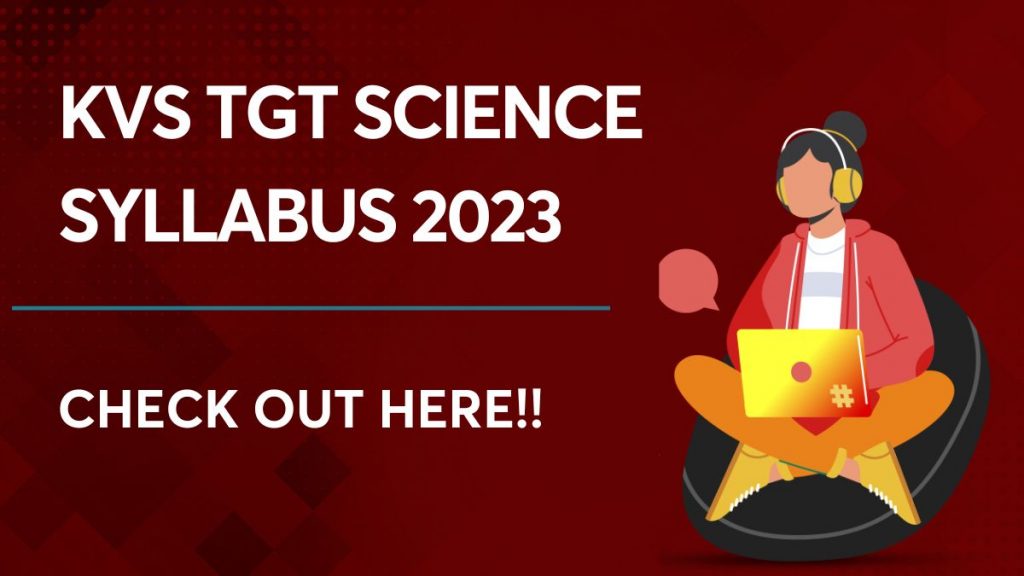Kendriya Vidyalaya Sangathan (KVS) has released the KVS TGT Science Syllabus 2023 for the upcoming recruitment. Candidates who have already begun their exam preparation can now check KVS Trained Graduate Teacher Syllabus Subject Wise. They must have a profound knowledge of the syllabus to perform well in the exam. We have shared the KVS TGT Syllabus and exam pattern for all teachers of Hindi, English, Sanskrit, Mathematics, and Social Studies along with the KVS TGT Syllabus Science.
The KVS officials announce the KVS TGT Syllabus for the applicants who wish to be selected for the post of teacher. The relevant details about the course and exam pattern may help them to achieve their goals. We will also share the KVS TGT Science Syllabus PDF and KVS TGT Exam Pattern 2023 for ease of the candidates.
KVS TGT Science Syllabus 2023: Main Highlights
A number of vacancies are announced every year for the KVS Teacher Recruitment. This is why the exam level is becoming more difficult day by day. To qualify for this exam contenders need to make a perfect preparation plan for the upcoming Kendriya Vidyalaya (KVS) TGT Exam. Aspirants who are sincerely preparing for this exam, want to know about the Syllabus of KVS TGT Science. Let’s first check out some useful information regarding KVS TGT Syllabus Science and other subjects here!
| Particulars | Summary |
| Department Name | Kendriya Vidyalaya Sangathan (KVS) |
| Designation | Trained Graduate Teacher (TGT) |
| Recruitment Name | KVS TGT Recruitment 2023 |
| Job Location | All Over India |
| Exam Level | Central Level Exam |
| KVS TGT Science Syllabus 2023 status | Available |
| Category of the Article | Syllabus |
| Official Website | http://kvsangathan.nic.in/ |
Check the latest updates below-
KVS Science Syllabus 2023
Here, we will provide the KVS Syllabus for TGT Science which can be helpful for all those aspiring contenders who are preparing for this exam. The following table will list the important topics of the KVS TGT Syllabus Science. Read it thoroughly to learn more!
| Topic Name | Details |
| Fun with magnets | Magnetic materials, Magnetic poles, finding North and South Poles. |
| Heat | Temperature and measurement of temperature- Modes of Transmission of heat conduction, Clinical and Laboratory thermometer. |
| Friction | Definition, Advantages and Disadvantages of friction, Types of friction. |
| Motion | Distance and displacement, Acceleration, Distance-time and Velocity-time graphs uniformly accelerated motion, Velocity; Uniform and Non-uniforrı motion along a straight line; Elementary idea of uniform circular motion. |
| Force and Newton’s laws | Force and motion, Inertia of a body, Inertia and mass, Newton’s laws of motion, Momentum, Action and Reaction forces. |
| Gravitation | Universal law of gravitation, Acceleration due to gravity; Mass and weight; Force of gravitation of the earth (gravity). Archimedes’ principle, Elementary idea of relative density. |
| Magnetic effects of current | Magnetic field, Field lines, Field due to a current carrying conductor, Field due to current carrying coil or solenoid; Fleming’s left-hand rule. Electromagnetic induction. The induced potential difference, Force carrying conductor, Induced current. Fleming’s Right-Hand Rule, Direct current. Alternating current, Domestic electric circuits. |
| Light | Reflection of light at curved surfaces, Centre of curvature, Principal axis, Principal focus, Images formed by spherical mirrors, Focal length. Mirror formula (Derivation not required) and magnification. |
| Sources of Energy | Different forms of energy, Conventional and non-conventional sources of energy: Biogas; Wind, Water and Tidal energy; Fossil fuels, Solar energy; Nuclear energy. Renewable versus non-renewable. |
| Microorganisms | Types of microorganisms – viruses, protozoa, algae, bacteria, fungi, Uses and harmful effects of microorganisms. The nitrogen cycle, Methods of food preservation. |
| Conservation of plants and animals | Causes and consequences of deforestation, Biosphere Reserve, Flora and fauna, Endemic Species, Red data book, Migration, Reforestation, Wildlife sanctuaries and National parks. |
| Matter | Characteristics of Solid. Compounds and mixtures, Valency, Chemical formula of common compounds. Nature and behaviour, particle nature, mole concept, the structure of the atom. |
| Natural resources | Our environment, ecosystem and environmental problems, conservation and management of natural resources. |
| Refraction | Laws of refraction, Refraction of light by a spherical lens, Image formed by spherical lenses, Magnification, Lens formula (Derivation not required). Power of a lens |
KVS TGT Exam Pattern 2023
The CBT Part one of the KVS TGT consists of General English and General Hindi and Part two will include General knowledge & Current Affairs, Reasoning Ability, Computer Literacy and Pedagogy. The following table shows the KVS TGT Exam Pattern 2023.
|
Test |
Subjects |
Number of Marks |
Number of Questions |
Exam duration |
|
Part I |
General English |
10 |
10 |
2 hours 30 minutes |
|
General Hindi |
10 |
10 |
||
|
Part II |
General knowledge & Current Affairs |
40 |
40 |
|
|
Computer Literacy |
10 |
10 |
||
|
Reasoning Ability |
40 |
40 |
||
|
Pedagogy |
40 |
40 |
||
|
Total |
150 |
150 |
||
KVS Science TGT Syllabus: FAQs
We have shared KVS Science TGT Syllabus on this page. Candidates are advised to go through this page to know in detail.
If you make a proper study plan and timetable, it will not take much time to master this subject.
One hundred and fifty questions will be asked in the KVS TGT Exam 2023.
Yes, you can visit the official website at kvsangathan.nic.in to download the syllabus.
The KVS TGT Exam has two parts – part one and part two. In part one, there are two subjects: General Hindi and General English. In part two, there will be four subjects to cover- General knowledge & Current Affairs, Reasoning Ability, Computer Literacy and Pedagogy.
